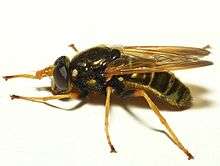Caliprobola speciosa
Calliprobola speciosa is a Palearctic hoverfly. It is an ancient woodland bioindicator.
| Caliprobola speciosa | |
|---|---|
 | |
| Caliprobola speciosa Netherlands | |
| Scientific classification | |
| Kingdom: | |
| Phylum: | |
| Class: | |
| Order: | |
| Family: | |
| Genus: | |
| Species: | C. speciosa |
| Binomial name | |
| Calliprobola speciosa Rossi, 1790 | |
Description
For terms see Morphology of Diptera
Calliprobola speciosa is a large (wingspan : 13-17 mm. slender -bodied hoverfly. The body is brassy aeneous or dark metallic green. The base of the abdomen is black. Tergites 2, 3 and 4 have a thin black transverse line followed by a broad metallic green band, a thin black transverse line broken in the middle and a transverse stripe of golden hairs. The prominent orange yellow frons is projecting and coned. The face is yellow. The legs are yellow, only the base of the femora black. The wings are yellowish and dark shaded at the tip.[1][2] [3][4][5][6][7]The larva is described and figured by Rotheray (1994) [8]
Distribution
Europe, from southern England to northern Spain and across the Palearctic as far as eastern Siberia.Not in Scandinavia and northern regions. [9][10]
Biology
The habitat is Quercus and Fagus and Castanea ancient woodland where the larvae develop in decaying stumps. Flowers visited are white umbellifers, Caltha, Crataegus, Rorippa, Rubus, Sorbus aucuparia, Tamarix. Adults fly from mid May to mid July.[11]
References
- Bradescu, V. (1991) Les Syrphides de Roumanie (Diptera, Syrphidae), Clés de détermination et répartition. Trav.Mus.Hist. nat. Grigore Antipa, 31: 7-83.
- Van der Goot,V.S. (1981) De zweefvliegen van Noordwest - Europa en Europees Rusland, in het bijzonder van de Benelux. KNNV, Uitgave no.32: 275pp. Amsterdam.
- Stubbs, Alan E. & Falk, Steven J. (1983). British Hoverflies: An Illustrated Identification Guide (2nd (revised) ed.). British Entomological & Natural History Society. p. 271, xvpp. ISBN 0-9502891-3-2.
- Bei-Bienko, G.Y. & Steyskal, G.C. (1988a) Keys to the Insects of the European Part of the USSR, Volume V: Diptera and Siphonaptera, Part I. Amerind Publishing Co., New Delhi. ISBN 81-205-0080-6.
- Van Veen, M. (2004) Hoverflies of Northwest Europe: identification keys to the Syrphidae. 256pp. KNNV Publishing, Utrecht.addendum
- Van der Goot,V.S. (1981) De zweefvliegen van Noordwest - Europa en Europees Rusland, in het bijzonder van de Benelux. KNNV, Uitgave no.32: 275pp. Amsterdam.
- Coe, R.L. (1953) Diptera: Syrphidae. Handbks.ident.Br.insects, 10(1): 1-98. R.ent.Soc.London. pdf
- Rotheray G., 1993 Colour Guide to Hoverfly Larvae Diptera, Syrphidae in Britain and Europe Dipterists Forum pdf Archived 2019-04-03 at the Wayback Machine
- Fauna Europaea
- Peck, L.V. (1988) Syrphidae. In: Soos, A. & Papp, L. (eds.) Catalogue of Palaearctic Diptera, 8: 11-230. Akad.Kiado, Budapest.
- Speight, M.C.D. (2011). "Species accounts of European Syrphidae (Diptera)" (PDF). Syrph the Net, the database of European Syrphidae. 65: 285pp.